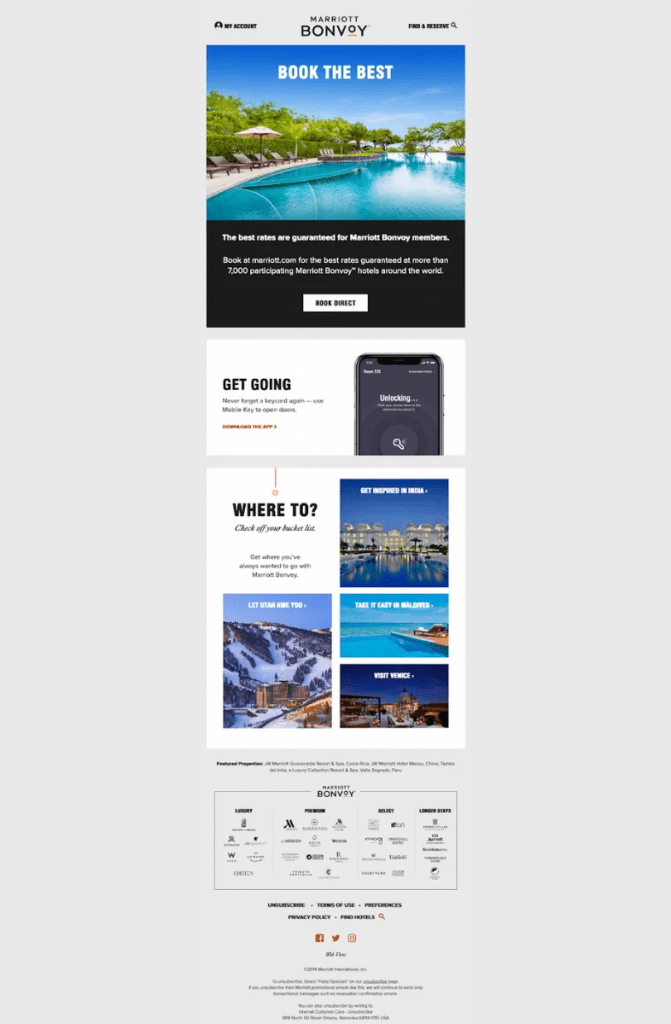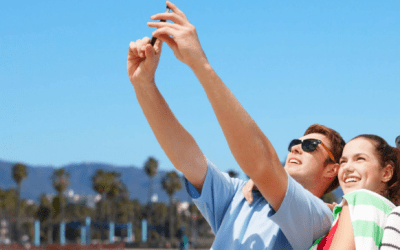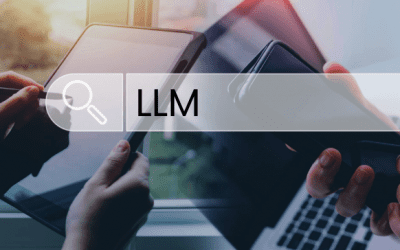This article inaugurates our new series dedicated to the strategic and comparative analysis of landing pages among leading brands in the tourism sector. We will start with Marriott, a global benchmark in hospitality, highlighting its strengths and proposing opportunities to enhance its digital marketing strategy.
Comparative Analysis of Design and Usability
Marriott’s landing pages stand out for their clean aesthetics, intuitive navigation, and excellent visual balance. The images are expansive, captivating, and professionally curated, immediately inviting users to discover more about their destinations and services. Additionally, navigation elements are well distributed and easily accessible.
However, in certain cases, the initial density of information on mobile versions could be further reduced to streamline direct access to critical elements such as rates, exclusive offers, or reservation forms. Minimizing scrolling effort could significantly improve the initial user experience, especially on mobile devices where attention is limited, and every second counts. Likewise, incorporating interactive filters from the outset could further facilitate navigation, particularly for returning users seeking quick and efficient reservations.
Conversion Strategies on Landing Pages
Marriott’s digital marketing strategy implements effective calls to action (CTAs) with clear, direct, and visually appealing messages that instantly capture users’ attention. Promotions targeted specifically at Marriott Bonvoy program members are particularly prominent, offering tangible and clear benefits that encourage immediate conversion.
However, there is significant room for improvement in the optimization of reservation forms. Currently, some forms require excessive information at initial stages, potentially discouraging new customers. Implementing progressive forms or reducing mandatory fields could effectively reduce friction and increase conversion rates. Additionally, it would be beneficial to implement cart abandonment recovery strategies through automated emails, contextual reminders, or additional incentives to guide users back towards conversion.

The Role of Storytelling and Visual Content
Marriott is renowned for its ability to generate powerful and emotionally resonant visual narratives that allow users to vividly imagine experiencing the brand’s offerings. Carefully curated images and well-produced videos effectively communicate the distinctive value of their hotels.
However, to deepen this emotional connection, Marriott could incorporate more direct narrative content from customers, such as short personal stories or brief testimonials in video format, complementing and enriching existing storytelling, thus delivering an even more personal and authentic impact. Similarly, strategic use of 360-degree videos could allow users to explore rooms and common areas more immersively.
Integration of Social Media and Digital Marketing
Marriott’s social media integration is robust and effectively executed. Social media campaigns frequently and effectively redirect users to landing pages, generating quality traffic. The use of real testimonials also significantly strengthens trust perception.
Nevertheless, Marriott could further leverage the potential of user-generated content (UGC) through highly segmented remarketing strategies. Additionally, exploring higher levels of social interaction directly on the landing page—including interactive elements that facilitate real-time sharing of experiences—would encourage greater spontaneous social engagement. Moreover, Marriott could subtly incorporate dynamic content about their destinations—such as Smartvel’s specialized destination content—to boost page retention and user interest, potentially fostering reservations.
Personalization and Experience Segmentation
Marriott’s ability to segment and personalize the user experience is clear and highly effective, significantly enhancing content relevance and conversion rates. They skillfully utilize geolocation and personalization based on users’ previous behaviors.
However, a fundamental improvement would be to provide greater transparency regarding the personalization practices they employ, allowing users to clearly understand how their information is used and easily adjust their preferences. This would not only improve trust but also reinforce the perceived value of these personalized experiences.
Web Design Trends in the Tourism Sector
Marriott embraces current web design trends such as minimalism, responsive design, and micro-interactions, enriching the user experience without visually overloading the interface. Yet, Marriott could intensify the strategic use of micro-animations in specific interactive areas, such as reservations or highlighted sections, to enhance perceptions of fluidity and dynamism, particularly on mobile platforms where these animations can be critical in capturing attention and improving quality perception.
SEO, SEM, and Metrics Analysis on Landing Pages
In SEO and SEM, Marriott maintains a solid and well-managed performance, demonstrating consistency and growth in positioning. Strategic keywords are well-integrated and optimized for both organic searches and paid campaigns. Nonetheless, detailed metrics analysis using tools like Sistrix reveals additional opportunities for technical page optimization, specifically in Core Web Vitals and mobile load times, which could further enhance their organic positioning and efficiency of paid traffic.
Technological Innovation and Interactive Experiences
Marriott consistently invests in innovative technologies such as chatbots and virtual assistants to enhance real-time interaction and streamline operational processes. However, to differentiate itself further in an increasingly competitive market, Marriott should consider a more aggressive incorporation of immersive experiences using augmented reality or advanced virtual tours on their landing pages. These technologies not only enhance interaction but also reinforce a perception of innovation and technological leadership, crucial for attracting younger and technologically sophisticated user segments.

Marriott sets a high standard with its web design, digital integration, and conversion strategies. Nevertheless, there are opportunities for improvement in form simplification, increased transparency in personalization, advanced technological innovation, and better technical optimization in SEO/SEM—areas that, if developed, could further elevate its leadership position. This analysis balances deserved recognition with specific recommendations for future improvements, setting a positive precedent for upcoming analyses in this series.






